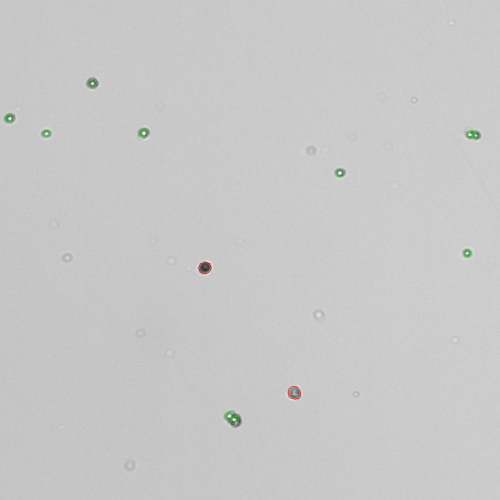Produced in Partnership with DeNovix Inc.Sep 1 2022Reviewed by Louis Castel
Insect cells like the SF9 cell line separated from Spodoptera frugiperda are generally utilized in the process of recombinant protein production with the help of baculovirus.
This technique of protein production requires precise knowledge of SF9 cell counts and viability to authorize healthy cells to produce protein and successful transfection.
This technical note explains how the CellDrop FL Automated Cell Counter allows quick and precise cell viability and cell count determination. Two techniques were utilized to quantify cell viability: Trypan Blue dye exclusion and Propidium Iodide fluorescent dye labeling or Acridine Orange.
Materials and Methods
SF9 cells were mildly sloughed from culture for the maintenance of viability. Furthermore, cells were centrifuged at 100 g and resuspended in PBS for counting.
Trypan Blue
The cells present in PBS were blended in the ratio 1:1 with Trypan Blue (DeNovix CAT #CD-TRY-1.5) and counted with the help of the Trypan Blue app on the CellDrop Cell Counter by making use of the default protocol explained below:
Table 1: SF9 counting protocol for the Trypan Blue app. Source: DeNovix Inc
| . |
. |
| Dilution Factor |
2 |
| Minimum Diameter |
6 |
| Maximum Diameter |
30 |
| Live Roundness |
50 |
| Dead Roundness |
25 |
| Stained Threshold |
35 |
| Small Cell Mode |
OFF |
| Irregular Cell Mode |
OFF |
AO/PI
SF9 cells in PBS were blended in the ratio of 1:1 with AO/PI (DeNovix CAT #CD-AO-PI-1.5) and counted in the AO/PI app on the CellDrop Cell Counter using the protocol explained below:
Table 2: SF9 counting protocol for the AO/PI app. Source: DeNovix Inc
| . |
. |
| Dilution Factor |
2 |
| Minimum Diameter |
8 |
| Maximum Diameter |
20 |
| Live Roundness |
1 |
| Dead Roundness |
1 |
| Green FL Threshold |
1 |
| Red FL Threshold |
12 |
| Irregular Cell Mode |
OFF |
Results and Summary
The CellDrop Automated Cell Counter helps count cells and reports their viability, thereby surrounding dead cells in red and live cells in green. The Trypan Blue app determines unstained cells as live and stained (dark) cells as dead and further labels them as such (Figure 1).

Figure 1. SF9 cells counted in the Trypan Blue app on the CellDrop Automated Cell Counter. Live cells are circled in green and dead, stained cells are circled in red. Image Credit: DeNovix Inc
The AO/PI app determines green-fluorescing cells as viable live cells, and red-fluorescing cells as dead (Figure 2). CellDrop allows quick and precise counting and identification of live and dead cells in a range of mammalian and other cell types, such as the SF9 insect cell line.

Figure 2. SF9 cells counted in the AO/PI app on the CellDrop Automated Cell Counter. Green-fluorescing live cells are circled in green and red-fluorescing dead cells are circled in red. Image Credit: DeNovix Inc
Eliminate Costs | Automate Cell Counting
About DeNovix, Inc..jpg)
DeNovix Inc. is an instrumentation company that designs, manufactures and sells award-winning laboratory equipment to meet the demands of today’s evolving life science technologies. Our focus is on providing innovative products and outstanding customer support. DeNovix is equipped with the financial, commercial and technical resources to deliver breakthrough products for your research success.
DeNovix offers the DS-11 Series Spectrophotometer/Fluorometer which combines fluorescence analysis and 1uL UV-Vis in the same instrument. Coupled with our suite of RNA and dsDNA Fluorescence assays, DeNovix instruments provide a wider quantification range than any other instrument.
DeNovix also produces CellDrop™ Automated Cell Counters which eliminate costly single-use plastic slides from cell counting workflows. A simple load, count and wipe-clean process allows counting and viability analysis in seconds.
DeNovix instruments are found in life science research labs world-wide. Each instrument is a stand-alone system controlled by a built-in custom operating system -no PC or tablets required. Labs love the smart-phone-like operation, impressive performance and the flexible connectivity of the instrument. Learn more about DeNovix Instruments and how they can benefit your lab.
Sponsored Content Policy: AZO Life Science publishes articles and related content that may be derived from sources where we have existing commercial relationships, provided such content adds value to the core editorial ethos of AZO Life Science, which is to educate and inform site visitors interested in medical research, science, medical devices, and treatments.